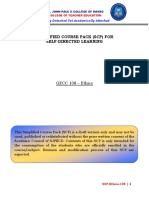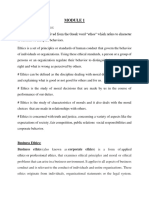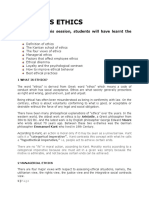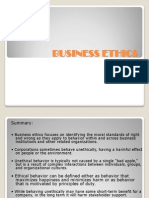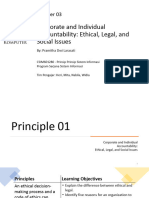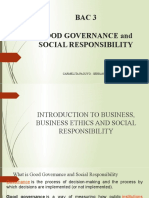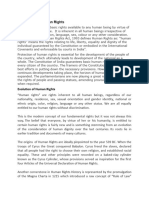Definition and Overview of Ethics
Uploaded by
Raiza CartagoDefinition and Overview of Ethics
Uploaded by
Raiza CartagoBM1708
QUALITY MANAGEMENT, ETHICS, AND CORPORATE SOCIAL RESPONSIBILITY
Definition and Overview of Ethics
• Ethics is a set of guiding principles that govern humans’ right and wrong actions.
• It is about doing the right thing within a moral framework.
• Stevenson (2015) identifies five (5) principles for thinking ethically:
o Utilitarian Principle. It states that the good result of an action should outweigh any harm that it
might cause.
o Rights Principle. It states that actions should respect and protect the moral rights of others.
o Fairness Principle. It states that equality should prevail in any given situation.
o Common Good Principle. It states that actions should contribute to the general welfare of the
community.
o Virtue Principle. It states that actions should be consistent with certain ideal virtues.
Trust, Values, Integrity, and Responsibility
• Trust. It pertains to the belief earned by a person who is reliable and honest. The various elements of
total quality that depends on trust include communication, interpersonal relations, conflict
management, problem solving, teamwork, employee involvement and empowerment, and customer
focus.
• Values. It pertains to deeply held beliefs of a person that form the very core of that particular person.
Values that lead to ethical behavior include fairness, dependability, integrity, honesty, and
truthfulness. These values tend to encourage a work environment that involves, empowers, values,
and nurtures people.
• Integrity. It reflects the ability of a person to display honesty and strong moral principles. In a total
quality environment, people with integrity can be counted on to do the right thing, do things correctly,
accomplish tasks thoroughly and completely, finish work on time, and keep promises.
• Responsibility. It pertains to the accountability of a person to take ownership for his/her actions.
Accepting responsibility helps build trust, integrity, and all the other elements of ethics that are
important in a total quality environment.
Manager’s Role in Ethics
The role of managers in establishing an ethical work setting consists of three (3) approaches.
• Best-Ratio Approach. It is based on the belief that people are basically good. People will ethically
behave under right circumstances and will be driven to unethical behavior under certain conditions.
Managers should promote ethical behavior and maintain the best possible ratio of good choices to
bad choices and ethical behavior to unethical behavior. When hard decisions must be made, managers
should make the choice that will benefit most people.
• Black-and-White Approach. It is based on the certainty that right is right, wrong is wrong, and
conditions are irrelevant. The manager’s job is to make ethical decisions and carry them out to help
employees behave ethically regardless of circumstances. When difficult decisions must be made,
managers should make fair and impartial choices regardless of the outcome and do the right thing
without concern for short-term circumstances.
03 Handout 1 *Property of STI
Page 1 of 3
BM1708
• Full-Potential Approach. It is based on the philosophy that people are responsible for realizing their
full potential within the confines of morality. When a decision needs to be made, managers should
base the decision on how they will affect the ability of those involved to achieve their full potential.
Organization’s Role in Ethics
The organization’s responsibilities are to: (1) create an ethical environment in which stakeholders know
that they will be supported when making ethical choices and (2) ensure that all people in positions of
authority in the organization set an example of living up to the highest ethical standards.
• Creating an Ethical Environment. An organization creates an ethical environment by establishing
and enforcing policies and practices that ensure that all employees are treated ethically. Managers
must develop an ethics philosophy with specific guidelines that will serve as an ethical standard in
the organization.
• Setting an Example. An organization that takes the “Do as I say, not as I do” approach to ethics will
not succeed. Managers must behave or act in accordance to the ethical standards of the
organization in order to earn trust from the employees.
Models for Making Ethical Decisions
The following are the most widely used models for making ethical decisions:
• Full-disclosure Model. This model pertains to the ability of the organization to express their actions
to the satisfaction of a broad cross-section of stakeholders. This suggests that management
decisions must be in accordance to the benefit of many.
• Doctrine of the Mean Model. In this model, the mean refers to the average or middle point
between two (2) extremes. This proposes that in any situation, a moderate middle-ground option
is likely to be an ethical option. In other words, this model suggests that moderation is ethical.
• Golden Rule Model. This model is based on the Golden Rule: “Do unto others as you would have
them do unto you.”
• Market Ethics Model. This is based on the belief that any legal action that promotes profitability
is ethical. Proponents of this model profess that the purpose of a business is to make a profit.
Consequently, what is ethical should be decided within a framework of profit and loss.
• Organizational Ethics Model. This model is based on loyalty to the organization. Its underlying
premise is that the most ethical decision is the one that best serves the organization’s interests.
• Equal Freedom Model. This suggests that organizations have the freedom to behave as they wish
as long as they do not infringe on the rights of stakeholders.
• Proportionality Ethics Model. This model is based on the assumption that the world is so complex
that decisions are seldom clearly right or wrong. Consequently, the best an organization can do is
to make sure that the good outweighs the bad when making decisions.
• Professional Ethics Model. This is based on the principle of peer review. It states that a decision is
ethical if it can be explained to the approval of a broad cross-section of professional peers.
Beliefs vs. Behavior
The following are the several reasons that explain the disparity between the belief and behavior of people:
• Self-interest and Self-protection. People are, by their very nature, self-interested and, as a result,
self-protective. Most people work against human nature to put someone else’s needs ahead of
03 Handout 1 *Property of STI
Page 2 of 3
BM1708
their own. Yet, this is precisely what one must do to deal ethically with fellow employees and the
public at large.
EXAMPLE: John had some minor repair work to do on his personal truck but didn’t have a certain
tool he needed. Consequently, at the end of his shift at Autoworld Inc., he borrowed the needed
tool from the company’s tool locker. That night, he completed the work on his personal truck, but
the next morning he forgot about the tool and left it at home. The tool was needed to complete a
job at Autoworld Inc. during the next morning, and the shift supervisor began asking for anyone
who might have borrowed the tool. John is in the situation where he wants to protect his self-
interest by not admitting that he was the one who borrowed the tool because he knows that he
will be reprimanded.
• Conflicting Values. People who believe in ethical values (honesty, loyalty, fairness, etc.) sometimes
find themselves in situations where these values seem to conflict.
EXAMPLE: Mary Ann has an opportunity to win a contract to supply all the kitchen cabinets for a
56-house subdivision that is going to be built in the near future. But there is a problem; their
company cannot deliver the cabinets by the required date. Failure to deliver on time will throw off
the customer’s entire production schedule. Mary Ann’s boss is pressuring her to agree to the
delivery date, even though they both know that the deadline cannot be met. Mary Ann is in a
situation where she wants to be honest to their customer but also wants to maintain loyalty to the
company by deceiving the customer in order to close the sale.
• Tangible or Intangible, Immediate or Deferred. People frequently make decisions that contradict
their beliefs because the benefits of ethical decisions are often intangible or deferred while the
perceived benefits of unethical decision are usually both tangible and immediate.
EXAMPLE: In the case of Mary Ann, if she is willing to deceive the contractor by submitting a false
delivery date, there will be a direct benefit that is both immediate and tangible. Her company will
win a badly needed contract and she will be the author of the victory. The downside is that at some
point in the future, the company will lose the trust and, as a likely result, the future business of the
contractor she deceived. The benefit in this situation is immediate; the downside is deferred.
• Making Ethics Tangible and Immediate. Since the benefits of ethical behavior can be perceived as
being intangible and deferred, people will sometimes choose the unethical option—even people
who believe in ethical values. In a given situation, management expects ethical behavior but does
not reward it or, worse yet, unknowingly rewards unethical behavior.
EXAMPLE: In the case of Mary Ann, the upper management could have supported the supervisor
in doing the unethical decision instead of May Ann, in doing the ethical decision.
References:
Heizer, J., Render, B., & Munson, C. (2017). Operations management: Sustainability and supply chain
management (12th ed.). Boston: Pearson Education, Inc.
Stevenson, J. (2015). Operations management: Twelfth edition. New York: McGraw-Hill Education
03 Handout 1 *Property of STI
Page 3 of 3
You might also like
- This Matter of HONESTY: Third of A SeriesNo ratings yetThis Matter of HONESTY: Third of A Series3 pages
- MODULE in ETHICS-7 Framework and Principles100% (1)MODULE in ETHICS-7 Framework and Principles19 pages
- Responsible Leadership - Session 2 and 4 (1)No ratings yetResponsible Leadership - Session 2 and 4 (1)20 pages
- Quality Management, Ethics, and Corporate Social ResponsibilityNo ratings yetQuality Management, Ethics, and Corporate Social Responsibility14 pages
- Quality Management, Ethics, and Corporate Social ResponsibilityNo ratings yetQuality Management, Ethics, and Corporate Social Responsibility13 pages
- Business Ethics and Social ResponsibilityNo ratings yetBusiness Ethics and Social Responsibility46 pages
- 29-05 - 2023-Week 4 Applying Moral Philosophies in BusinessNo ratings yet29-05 - 2023-Week 4 Applying Moral Philosophies in Business30 pages
- Business Ethics: by The End of This Session, Students Will Have Learnt The FollowingNo ratings yetBusiness Ethics: by The End of This Session, Students Will Have Learnt The Following5 pages
- Business Ethics: by The End of This Session, Students Will Have Learnt The FollowingNo ratings yetBusiness Ethics: by The End of This Session, Students Will Have Learnt The Following5 pages
- Introduction To Business Ethics and Social Responsibility0% (1)Introduction To Business Ethics and Social Responsibility31 pages
- WEEK 13 NOTES Ethics in Financial Services MarketingNo ratings yetWEEK 13 NOTES Ethics in Financial Services Marketing9 pages
- Ch03-Corporate and Individual AccountabilityNo ratings yetCh03-Corporate and Individual Accountability59 pages
- "Models of Ethical Behaviour in Business": Course Name: Course Code: EMBA 510No ratings yet"Models of Ethical Behaviour in Business": Course Name: Course Code: EMBA 5105 pages
- Business Ethics and Social ResponsibilityNo ratings yetBusiness Ethics and Social Responsibility11 pages
- Making Ethical Decisions and Managing a Socially Responsible BusinessNo ratings yetMaking Ethical Decisions and Managing a Socially Responsible Business33 pages
- Ethics, Justice, and Fair Treatment in Human Resource ManagementNo ratings yetEthics, Justice, and Fair Treatment in Human Resource Management32 pages
- BUSINESS ETHICS.Module 2-Ethics-and-Business.pptxNo ratings yetBUSINESS ETHICS.Module 2-Ethics-and-Business.pptx32 pages
- Ethics in The Workplace Supplemental Self Study PresentationNo ratings yetEthics in The Workplace Supplemental Self Study Presentation51 pages
- Infusing Values and Ethics in An Organization-Full PaperNo ratings yetInfusing Values and Ethics in An Organization-Full Paper9 pages
- Bac 3 Good Governance and Social Responsibility: Carmelita Paguyo - SerranoNo ratings yetBac 3 Good Governance and Social Responsibility: Carmelita Paguyo - Serrano39 pages
- Social Responsibility and Management EthicsNo ratings yetSocial Responsibility and Management Ethics21 pages
- Managing Ethics and Social ResponsibilityNo ratings yetManaging Ethics and Social Responsibility7 pages
- Ethical Leadership and decision model updatedNo ratings yetEthical Leadership and decision model updated103 pages
- Professional Ethics: An Overview of Ethics100% (1)Professional Ethics: An Overview of Ethics24 pages
- Journal of Philosophy, Inc. The Journal of PhilosophyNo ratings yetJournal of Philosophy, Inc. The Journal of Philosophy17 pages
- Determinants of Human Acts and How It Differ To Acts of Man80% (5)Determinants of Human Acts and How It Differ To Acts of Man3 pages
- Pendekatan Dalam Pengambilan Keputusan Etis: Setiawati Mulyo (1056018)No ratings yetPendekatan Dalam Pengambilan Keputusan Etis: Setiawati Mulyo (1056018)14 pages
- Human Flourishing As Reflected in Progress and Development100% (2)Human Flourishing As Reflected in Progress and Development3 pages
- Recolcolin - PROFESSIONAL ETHICS JURISPRUDENCE AND CULTURAL SENSITIVITY MIDTERM EXAM100% (1)Recolcolin - PROFESSIONAL ETHICS JURISPRUDENCE AND CULTURAL SENSITIVITY MIDTERM EXAM4 pages





